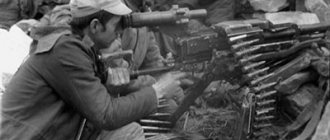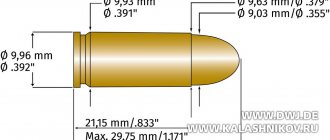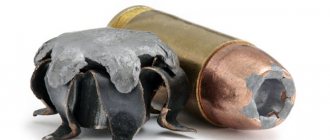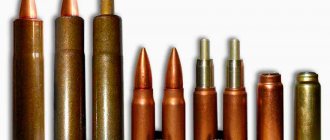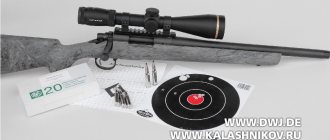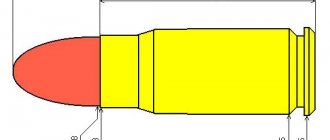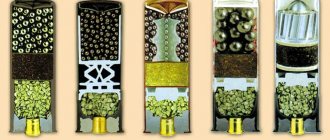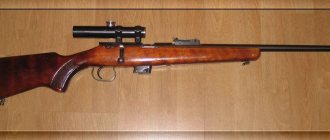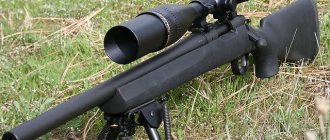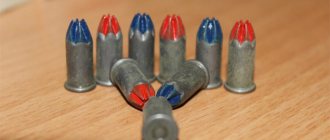| 7.62 × 54 mm R | |
| Various 7.62x54mm R | |
| Chuck type | rifle |
| Manufacturer country | Russian Empire USSR Russia Finland China DPRK Yugoslavia ATS countries, etc. |
| Type of weapon using cartridge | rifles, machine guns |
| Service history | |
| Operating time | 1891–present |
| Used | Russia, USSR, Russian Empire, Finland |
| Wars and conflicts | World War I, World War II, Winter War, virtually all armed conflicts in the Eastern Hemisphere after World War II and to the present day |
| Production history | |
| Time of creation | 1890 |
| Years of production | 1891–present |
| Options | see cartridge nomenclature |
| Characteristics | |
| Chuck length, mm | 77.16 max |
| Real bullet caliber, mm | 7,92 -0,05 |
| Bullet weight, g | from 9.0…9.2 (BZT bullet) to 13.6…13.75 (model 1891) |
| Powder charge mass, g | 2,15…3,25 |
| Initial bullet speed, m/s | from 610…615 (sample 1891) to 860…875 (sample 1908/30) “L” |
| Bullet energy | from 2530…2600 (model 1891) to 3840…4151 (with a “BS-40” bullet model 1940) |
| Sleeve parameters | |
| Sleeve length, mm | 53,72 |
| Case neck diameter, mm | 8,53 |
| Sleeve shoulder diameter, mm | 11,61 |
| Case neck diameter, mm | 8,53 |
| Sleeve base diameter, mm | 12,37 |
| Sleeve flange diameter, mm | 14,48 |
| Media files on Wikimedia Commons | |
7.62×54 mm R
(7.62×53R; 7.62×54; 7.62×54R; from the English rimmed - welted, with a rim) - a unitary rifle cartridge with a sleeve with a protruding rim with dimensions of 7.62 × 53.72 mm, total maximum cartridge length 77.16 mm, bullet diameter 7.62 mm and muzzle energy 3500.
History[ | ]
It is one of the oldest rifle cartridges of modern times and probably the oldest cartridge still in widespread military use. The ballistics of the 7.62x54R cartridge are the most studied. The only equally widely used rifle/machine gun cartridge currently is the 7.62x51mm NATO cartridge.
1891—1917[ | ]
Appeared in 1890, in 1891 it was adopted as a cartridge for the Mosin three-line rifle.
At first, the cartridge was produced with a blunt-pointed (rounded) bullet, which weighed 13.6 g and had a length of 30.8 mm, secured in the muzzle of the cartridge case with an interference fit, later with the addition of two or three cores (called pokes at the end of the 19th century).
In 1908, a pointed bullet weighing 9.6 g was introduced into the Russian Empire, and they began to equip it with a cartridge of this caliber of the 1908 model. Both blunt-pointed and pointed bullets were two-element: a lead core in a cupronickel silver shell.
During the First World War, the military industry of the Russian Empire failed to meet the needs of troops for rifle cartridges (by the beginning of 1915, the need of the active army was 150 million cartridges per month, and by mid-1917 it increased to 350 million cartridges per month, meanwhile, maximum productivity cartridge factories, reached only 150 million cartridges per month by November 1917. Orders for the production of three-line cartridges were placed in the UK and the USA, cartridges began to arrive in 1916. However, the monthly shortage of cartridges in the active army was 50 million cartridges per month) [1].
Due to the need to fire at armored vehicles and other protected targets, in May 1915 it was decided to develop an armor-piercing bullet with a steel core, and in 1916 the 7.62x54 mm cartridge with an armor-piercing bullet was adopted by the Russian army. Captain Kutovoy.
1917—1991[ | ]
On December 31, 1926, by order of the Revolutionary Military Council of the USSR No. 744/141, the armor-piercing bullet of the engineer Boyno-Rodzevich system for the 7.62 mm rifle cartridge was adopted into service with the Red Army; By the same order, the armor-piercing bullet of the Kutovoy system for the 7.62 mm rifle cartridge was removed from service with the Red Army [2].
After modernization in 1930, the cartridge received the designation M1908/30. In connection with the development of new weapon systems in the 1930s, Soviet gunsmith designers developed new types of cartridges: designers Dobzhansky and Smirnsky developed a cartridge with a heavy bullet mod. 1930 for heavy machine guns; a cartridge with the B-30 armor-piercing bullet, a cartridge with the T-30 tracer bullet (the tracer composition for which was developed by specialists A.S. Ryabov and A.G. Tsialov), etc. were also created.[3]
For the ShKAS aircraft machine gun, under the leadership of N. M. Elizarov, in the early 1930s, cartridges were developed that had tracer, incendiary and combined action armor-piercing incendiary bullets capable of igniting gasoline tanks protected by armor. In these cartridges, to prevent the cartridge from being dismantled (dismantled) at a huge rate of fire of 30-50 rounds per second, the walls of the cartridge case are thickened, the fastening of the primer in the socket is strengthened, and a double ring crimp of the bullet is introduced in the barrel of the cartridge case. At the bottom of the cartridge case for ShKAS machine guns, in addition to the standard designations, the letter “Ш” was placed. The capsule is painted red. Otherwise, the coloring is standard for the corresponding types of bullets. Cartridges intended for infantry weapons could not be used in ShKAS machine guns. The cartridges for the ShKAS machine gun were the world's first special aviation cartridges.
Brand on the cartridge for the ShKAS machine gun. Plant No. 529 Novaya Lyalya
In the second half of the 1930s, some factories mastered the production of 7.62 mm rifle cartridge cases from cold-rolled steel strip, which made it possible to reduce the consumption of non-ferrous metals[4].
By 1941, as a result of the automation of mechanical operations for the production of cartridges, the labor intensity of manufacturing 7.62 mm rifle cartridges was reduced by 70%[5].
After the start of the Great Patriotic War, the active army's need for ammunition increased, and in 1941, two cartridge factories began producing 7.62 mm steel rifle cartridge cases[6].
In 1943, based on the cartridge, an intermediate cartridge of 7.62x41 mm was created, and later 7.62x39 mm.
After the end of the Great Patriotic War, the cartridge became widespread in the armies of socialist states (in particular, it was a standard rifle and machine gun cartridge in the countries of the Warsaw Pact Organization).
After 1991[ | ]
7.62x54 mm cartridges are still in service in a number of countries around the world; they are mass-produced and used as ammunition for sniper rifles and machine guns, PKM, PKP.
In addition, the cartridge has become widespread in many countries as ammunition for civilian sporting and hunting weapons.
Sniper cartridge
Sniper cartridges of 7.62 caliber
The cartridge, as one of the main components of the sniper complex, first of all, naturally, must ensure maximum shot accuracy, that is, minimal deviation of the bullet’s flight path from the calculated one. This is implemented by a whole range of measures at all stages: from internal and external ballistic calculations to high precision manufacturing of all cartridge elements and their storage conditions until the moment of use. At the time of the birth of sniping, that is, accurate shooting by specially trained shooters, as a method of conducting military operations, this entire complex was decided by the sniper himself. He poured the bullets himself, used trial and error to select the optimal charge, carried ready-made cartridges, ensuring their safety. The principle “as you drown, you burst” was preserved until the armies were rearmed with uniform types of small arms. Supplying relatively small sniper units and individual shooters with special weapons, fundamentally different from the standard ones, and even more so with special cartridges, in the combat zone caused enormous difficulties. If at the beginning of the First World War the British still used some samples of target rifles at the front, in particular chambered for the rather powerful .333 Jeffery cartridge, then by the end of the war almost all snipers were re-equipped with rifles, specially selected or modified in some way, used in linear parts. In addition to the presence of an optical sight, the sniper rifle was distinguished by improved processing of the barrel bore and sometimes a thicker and longer barrel. For shooting, standard cartridges from batches that showed the best accuracy were used.
Perhaps the only exception during the period between the two world wars was the United States, where shooting with military weapons is still one of the favorite national pastimes. The Americans, despite their pathological passion for reloading, produced for competitions in quite large quantities target versions of .30-06 SPRG cartridges under the names Rifle Anneal, National Match, Palma Match, International & Palma Match or simply Match. These cartridges also entered the army. This system has survived to this day, only instead of the .30-06 SPRG, the 7.62x51 Match is used, based on the standard NATO cartridge in service.
Apparently, priority in adopting a special sniper cartridge belongs to the Finnish army. At the very beginning of the 1940s, the D47 bullet was adopted for the standard 7.62x53R cartridge, which differs from the standard D46 in the absence of a flute for compressing the cartridge case in the muzzle, which increases dispersion, and in higher manufacturing accuracy. Finnish bullets differ from all other bullets for target shooting adopted in other countries to this day by the presence of a noticeable step in the transition from the cylindrical leading part to the conical bottom. The origin of this feature is most likely connected with the system of supplying the Finnish army with weapons and ammunition, which was built mainly on captured Soviet and rather “variegated” foreign weapons.
Sniper cartridge 7N1
In the USSR until the 1960s, there was no particularly urgent need for a special sniper cartridge. Until 1953, domestic factories produced cartridges with two types of ordinary bullets - light “L” and heavy “D”. Both consisted of a tombak-clad steel shell and a lead core, that is, they were two-component. The first had a conical depression in the bottom, the second had a more streamlined bottom part in the form of a truncated cone. It was used by snipers. In addition, target cartridges with a bullet very similar to a heavy one were also produced for sports competitions. The need to use two different sighting strips for different ballistics (L and D) forced the transition to a single LPS bullet - a light bullet with a steel core. The addition of a third component in large-scale production conditions naturally worsened the accuracy characteristics of the cartridge. This increased dispersion had no effect on the effectiveness of machine guns, the main consumer of 7.62 mm rifle cartridges, and sniper shooting became problematic. On the other hand, keeping a cartridge with a heavy bullet in service not only complicated the supply, but also required sighting devices with a different graduation, which made it difficult for the sniper to work if it was necessary to use machine-gun cartridges. As a result, a sniper cartridge was developed and adopted for service, receiving the index 7N1. The bullet of a sniper cartridge differs from the main LPS not only in manufacturing accuracy, but also in design. The soft steel core is shifted to the head of the bullet, which ensures a more accurate fit in the shell and eliminates the impact on the bullet’s penetration into the bore. This cartridge is in service with the Russian army to this day.
However, the proliferation of personal protective equipment in the armed forces has reduced the effectiveness of the 7N1 cartridge. To replace it, a new sniper cartridge with a heat-strengthened core, which has better penetration ability, is currently being tested. He received the index 7H14. With its adoption, the Russian army will become the only one in the world possessing a sniper cartridge with an armor-piercing bullet.
In addition to the 7N1, the 9-mm sniper cartridge 7N8, better known under the symbol SP5, has also been adopted for the 6P29 Vintorez silent sniper rifle. Our magazine has already written about the history of its creation.
Recently, combat missions have appeared that cannot be solved by a sniper complex consisting of an SVD rifle and a 7N1 cartridge. This is sniping at a distance of more than one kilometer. Of course, such problems existed before, but their real solution was hampered by the lack of effective portable sighting systems, which would include, in addition to strong optical sights, instruments for accurately measuring the range to the target and environmental parameters (temperature, humidity, wind speed) .
7N33 sniper cartridges
An attempt was made to solve the problem of ultra-long-range shooting using heavy sniper rifles chambered for a large-caliber B-94 cartridge. But testing the 12.7 mm sniper cartridge still causes a lot of trouble. Low maneuverability, excessive kinetic energy of the bullet to destroy manpower, and increased unmasking properties of this weapon also limit the scope of its application, forcing one to look for other solutions. For now, work is underway on a high-precision cartridge based on the 9x64 hunting cartridge, developed in the 70s by M. M. Blum. It is difficult to argue about the appropriateness of this choice, but the .338 Lapua Magnum cartridge, used in the West for shooting at a distance of about a kilometer, looks somehow more confident. Its prototype, the .338 BELL, was developed in 1983 from the .416 Rigby hunting cartridge for US Navy snipers.
If a rifle chambered for 9x64 or a similar cartridge with an effective firing range of up to a kilometer is adopted, the system of army sniper weapons will take on a more or less complete form.
The range of cartridges for police weapons is much wider. Naturally, this applies to Western models, since the sniper weapons of the Ministry of Internal Affairs of the Russian Federation and the Republic of Armenia are almost the same. The expansion is associated with additional restrictions imposed on the work of a police sniper, the main one of which is to minimize the likelihood of hitting random citizens in the event of a ricochet or through penetration of the target. This is achieved by using cartridges with increased speed due to a lighter and relatively easily deformed bullet. In addition, the usual range of a police sniper rarely exceeds 100-150 m. At such distances, it is advisable to use small-caliber cartridges.
These include .223 Remington, .22-250, 6 mm PPC, .243 Winchester cartridges, which are quite widely used by the US police. In rare cases of long-range shooting, the .308 Winchester, .30-06 SPRG, .300 Winchester Magnum and, finally, the .338 Lapua Magnum are used.
A sniper cartridge of 12.7x108 mm caliber, equipped with a special bullet weighing 56 g. The bullet develops an initial speed of 730 m/sec.
The need to increase the number of types of cartridges used has also arisen among domestic law enforcement agencies. This issue can be resolved in two ways. The first is to purchase imported samples, the second is to develop your own. At their own peril and risk, some special units try to use foreign-made weapons, encountering difficulties. The main one is the high cost of foreign cartridges and, consequently, the small amount of training.
Attempts are being made to adapt domestic models of sporting weapons and cartridges. Quite often, snipers use the “Extra” sports cartridge with a 13-gram bullet to shoot from the SVD.
For work in the city, MBO rifles chambered for 5.6x39 MBO were used. In terms of ballistic characteristics, it is close to the .223 Remington. You can shoot cheap and affordable 5.6x39 Bars from this rifle.
But the range of sports cartridges produced in the USSR, suitable for snipers, is not limited to these two samples. In the late 1960s, a batch of 5.6x45 Biathlon cartridges was produced with a 5-gram bullet and ballistics close to .22-250. In the early 60s, athletes used a 6.5 mm target rifle and a cartridge for it, created on the basis of a 7.62 mm rifle cartridge case, comparable in ballistics to .243 Winchester. By the way, there was a 7.62 mm rifle cartridge with a particularly light bullet with an aluminum core - with an initial speed of about 1200 m/s. Perhaps these cartridges were preserved in warehouses. Maybe the new is the well-forgotten old, and it’s worth trying it before starting expensive developments or spending money on imports?
Alexander Bortsov
Nomenclature of cartridges[ | ]
Russian and Soviet industry produced or is producing the following range of cartridges:
- 7.62 B-32 gzh (GRAU index - 57-БЗ-323/7-БЗ-3) - cartridge with an armor-piercing incendiary bullet B-32 and a bimetallic sleeve,
- 7.62 BP (GRAU index - 7N26) - cartridge with an armor-piercing bullet BP (7BM4),
- 7.62 BS (GRAU index - 7N37) - cartridge with sniper armor-piercing bullet BS,
- 7.62 LPS gzh (GRAU index - 57-N-323S) - a cartridge with a light LPS bullet with a steel core and a bimetallic sleeve,
- 7.62 T-46 gzh (GRAU index - 57-T-323) - cartridge with T-46 tracer bullet and bimetallic sleeve,
- 7.62 LS (GRAU index - 57-N-323U) - a cartridge with a light L bullet and a reduced powder charge weight, subsonic, for silent shooting (initial speed - 285-295 m/s) [7],
- 7.62 PZ gzh (GRAU index - 57-ZP-323) - cartridge with a PZ sighting-incendiary bullet and a bimetallic sleeve,
- 7.62 T-46 hl (GRAU index - 57-T-322) - cartridge with T-46 tracer bullet and brass sleeve,
- 7.62 T-46 (GRAU index - 7T2) - cartridge with T-46 tracer bullet,
- 7.62 T-46M (GRAU index - 7T2M) - a cartridge with a T-46M tracer bullet, the ignition of which occurs at a distance of 80-120m from the place of the shot,
- 7.62 T-46M1 (GRAU index - 7T2M1) - cartridge with T-46M1 tracer bullet,
- 7.62 B-30 gl (1930; GRAU index - 57-B-222) - cartridge with a B-30 armor-piercing bullet and a brass sleeve,
- 7.62 B-32 gl (1932; GRAU index - 57-BZ-322) - cartridge with an armor-piercing incendiary bullet B-32 and a brass sleeve,
- 7.62 B-32 gs (GRAU index - 7-BZ-3-01) - cartridge with a B-32 armor-piercing incendiary bullet and a steel sleeve,
- 7.62 BZT gl (GRAU index - 57-BZT-322) - cartridge with an armor-piercing incendiary tracer bullet BZT and a brass sleeve,
- 7.62 BO - sports ammunition with a lightweight bullet for competitions in bullet shooting at running deer targets,
- 7.62 L gzh (GRAU index - 57-N-323) - cartridge with a light L bullet with a bimetallic jacket and a bimetallic sleeve,
- 7.62 BT gl (GRAU index - 57-BT-322) - cartridge with an armor-piercing tracer BT bullet and a brass sleeve,
- 7.62 BT gzh (GRAU index - 7BT1) - cartridge with an armor-piercing tracer bullet BT-90 and a bimetallic sleeve,
- 7.62 D gzh (GRAU index - 57-D-423) - cartridge with a heavy (long-range) D bullet and a bimetallic sleeve,
- 7.62 D gl (GRAU index - 57-D-422) (1930) - cartridge with a heavy (long-range) D bullet and a brass sleeve,
- 7.62 Z gl (GRAU index - 57-Z-322) - cartridge with an incendiary bullet Z and a brass sleeve,
- 7.62 L gzh (GRAU index - 57-N-223) - cartridge with a light L bullet with a bimetallic jacket and a bimetallic sleeve (supplied in clips),
- 7.62 L gl (GRAU index - 57-N-221) - cartridge with a light L bullet with a nickel silver jacket and a brass sleeve (supplied in clips),
- 7.62 L gl (GRAU index - 57-N-222) - cartridge with a light L bullet with a bimetallic jacket and a brass sleeve (supplied in clips),
- 7.62 L gl (GRAU index - 57-N-321) - cartridge with a light L bullet with a nickel silver jacket and a brass sleeve,
- 7.62 L gl (GRAU index - 57-N-322) - cartridge with a light L bullet with a bimetallic jacket and a brass sleeve,
- 7.62 LPS gzh (GRAU index - 57-N-223S) - cartridge with a light LPS bullet with a steel core and a bimetallic sleeve (supplied in clips),
- 7.62 LPS GS (GRAU index - 57-N-223S-01) - cartridge with a light LPS bullet with a steel core and a steel sleeve,
- 7.62 P gl (GRAU index - 57-P-322) - cartridge with a sighting bullet P and a brass sleeve,
- 7.62 PZ gzh (GRAU index - 7-ZP-2) - cartridge with a PZ sighting-incendiary bullet and a bimetallic sleeve,
- 7.62 PZ gl (GRAU index - 57-ZP-322) - cartridge with a PZ sighting and incendiary bullet and a brass sleeve,
- 7.62 PZ GS (GRAU index - 7-ZP-2-01) - cartridge with a PZ sighting and incendiary bullet and a steel sleeve,
- 7.62 PP gzh (GRAU index - 7N13) - a cartridge with a bullet of increased penetration PP and a bimetallic sleeve,
- 7.62 PP gs (GRAU index - 7N13-01) - cartridge with a bullet of increased penetration PP and a steel sleeve,
- 7.62 SNB (GRAU index - 7N14) - sniper armor-piercing cartridge,
- 7.62 T-30 hl (GRAU index - 57-T-322) - cartridge with T-30 tracer bullet and brass sleeve,
- 57-U-322 - cartridge with reinforced charge and brass sleeve,
- 57-U-323 - cartridge with reinforced charge and bimetallic sleeve,
- 57-U-423 - high pressure cartridge,
- 57-X-322 - blank cartridge with brass sleeve,
- 57-X-323 - blank cartridge with bimetallic sleeve,
- 57-X-340 - blank cartridge,
- 57-NE-UCH - training cartridge,
- 7N1 - sniper cartridge.
Cartridge 7.62 CH (7N1)
Work on creating a special sniper rifle cartridge in the USSR began shortly after the end of World War II in early 1947.
At the beginning of development, the designers went by creating a heavy bullet with a low muzzle velocity, but during testing it was found that although the created cartridges were superior in accuracy to ordinary 7.62x54 mm R rifle cartridges, they were significantly inferior to them in muzzle velocity ( only 695 m/s) and the initial energy of the bullet, which made the ammunition low-power and unsuitable for sniper shooting.
Until 1965, a number of prototypes of 7.62 mm sniper cartridges with various types of bullets were created and tested, but none of them met the technical requirements. The work was carried out by employees of NII-61 together with the design bureau of the Novosibirsk Low-Voltage Equipment Plant.
In 1965, state tests took place at the research artillery range in Leningrad, as a result of which several prototypes of the developed sniper cartridges were selected for their refinement and additional comprehensive tests, as a result of which an experienced sniper cartridge with a non-heated core was recommended for adoption. 07975 was put into service in 1967 under the name of the 7.62 SN niper rifle cartridge and the GRAU index ( Main Rocket and Artillery Directorate of the Ministry of Defense of the Russian Federation) 7N1 .
Sniper rifle cartridge 7.62 CH (7N1)
Technical characteristics of the 7.62 CH (7N1) sniper rifle cartridge
| Cartridge weight, g: | 23,20 |
| Bullet weight, g: | 9,90 |
| Sleeve and shell material: | bimetal |
| Average bullet speed, m/s: | 815 — 830 |
| Maximum pressure of powder gases, average/highest, Kgs/cm²: | 2900/3100 |
| Firing accuracy, R100 at a distance of 300m, cm: | 8,0 |
| Number of cartridges in the box, pcs: | 880 |
The 7.62 CH (7H1) sniper rifle cartridge is designed to defeat enemy personnel at a distance of up to 1300 meters and is most effective when fired at a distance of up to 800 meters. The CH bullet consists of a bimetallic shell, a combined core - a steel core made of St. 10 steel in the head of the bullet and a lead core. The sniper cartridge has no visual differences from a cartridge with an LPS bullet without a colored nose.
Unlike the LPS bullet, the 7N1 steel core is located directly in the head (ogive) part of the shell and does not have a lead jacket around it, and the lead core occupies the leading and conical bottom part of the bullet. This made it possible to optimize the location of the bullet’s center of gravity and avoid technological eccentricity of the steel core, since the latter began to be precisely fixed inside the shell. It was the eccentricity of the steel core that was the main reason for the increased dispersion of LPS bullets.
The ogive-shaped steel core has a truncated apex, which forms a cavity about 3 mm deep in the head of the bullet. The formation of the cavity is explained by the difficulty of stamping pointed cores. The rear cone angle has been increased to 10 degrees.
7.62 mm sniper cartridge bullet 7.62×54 R CH (7H1)
The introduction of a steel core into the design of a sniper bullet not only ensured lead savings, but also made it possible to reduce the mass of the bullet to the value of the mass of the LPS bullet, which served to fulfill the requirement of matching their trajectories. Without the steel core, the total mass of the bullet would be about 12 grams. The edges of the bullet tail shell are cut without seaming and form a lower open cavity 2.5 mm deep. The location of the steel core in the head reduced the eccentricity of the bullet, providing greater accuracy while maintaining penetration.
Despite the complete external similarity of the 7N1 sniper rifle cartridge of the 1967 model with the 7.62-mm rifle-machine-gun cartridge with the LPS bullet, the difference between them is very significant: the dimensions of the cartridge case and the SN bullet and its elements, their outlines, and mass characteristics are maintained with high accuracy , the tolerances in the manufacture of sniper bullets are halved compared to bullets from general rifle cartridges.
This is very important, since even a slight change in the weight of the bullet in one direction or another has a significant impact on the results of shooting at long ranges.
It should be noted that the 7N1 sniper rifle cartridges with the CH bullet were the first and for a long time remained the only special military cartridges for sniper weapons in the world. The production of sniper cartridges was mastered by plant No. 188 (Novosibirsk Low-Voltage Equipment Plant) and continues to this day. Cartridges are produced only with bimetallic sleeves. The packaging of cartridges is marked with the inscription “SNIPER”.
In 1983, the Barnaul Machine Tool Plant produced a pilot batch of 7N1 sniper cartridges with a varnished steel sleeve, but they were not put into mass production.
Characteristics[ | ]
Bullets of the 7.62×54 mm R cartridge have the following penetrating effect:
- a steel helmet is pierced by a bullet with a steel core at a distance of 1700 m;
- body armor of IV protection class (according to Russian GOST R 50744-95) is pierced by a bullet with a steel core at a distance of 200 m;
- armor 7 mm thick at an impact angle of 90° is penetrated by an armor-piercing incendiary bullet at a distance of 550 m;
- a parapet made of densely compacted snow is pierced by all types[9] of bullets at a distance of 1000 m to a depth of 70-80 cm;
- an earthen barrier made of loose sandy loam soil is penetrated by all types of bullets at a distance of 1000 m to a depth of 25-30 cm;
- dry pine beams with a cross-section of 20x20 cm, fastened in stacks, are pierced by all types of bullets at a distance of 1200 m to a depth of 20 cm;
- brickwork is penetrated by all types of bullets at a distance of 200 m to a depth of 10-12 cm [10] [11].
Army and weapons
Adopted into service on July 3, 1963, the old Russian sniper rifle design has already lived for more than forty years.
Frankly, for a sniper rifle still in service today, the design used is ancient. In order to understand this better, let's imagine that when the SVD was first put into service in the Soviet Army, British snipers were still using .303 (7.7mm) caliber cartridges for Lee-Enfield No.4 Mk.1 rifles, and the Americans were still using fought with the Springfield M1903A1 rifles, as well as the A4, and M1, and finally the “D” models. However, forty years later, this self-loading sniper rifle is still very popular in the Russian army.
Considering the huge number of battles in which this rifle has been, we can say that its design is simply impeccable. It is also very interesting to note that the rifle has not undergone virtually any changes over these decades, although it has been supplemented with a modern folding version, but it looks exactly the same as it did 40 years ago. Despite all that has been said, the SVD has not stagnated and one aspect of it has recently been improved, we are talking about cartridges for it. The SVD can still use standard 7.62x54R cartridges, but new special sniper cartridges (the so-called 7N14) were introduced and launched in 1999. These modern cartridges replaced the 7N1, which had been in service with the Soviet army since 1966. So, although the rifle looks exactly the same, specifically in order to achieve a more accurate hit on the target, namely to reduce spread and increase hits, its ammunition has been significantly modified.
For those unfamiliar with this cartridge, the 7.62x54R has the distinction of being the caliber that has remained in service the longest and is still used as a primary strike force today. Introduced in 1891, when American guns were still loaded with black powder and the .45-70 caliber cartridge, this new caliber outlasted the American .45-70, 30-40, Krag, and then the 30-03, 30-06 and 7.62x51. The first serious battle in which this amazing caliber took part occurred during the Russo-Japanese Company, which took place in 1904-1905. The original cartridge of this caliber was used in both rifles and machine guns, it consisted of a round-nosed jacketed bullet (with a full metal jacket) weighing 210 grains. Although it was a lethal caliber, some experts considered it to be insufficiently advanced. The two biggest criticisms leveled at him were that the bullets fired at the target had a rainbow trajectory, and therefore lost their accuracy on the battlefield. But when Russian gunsmiths began working on improving the 7.62x54R caliber, already in the summer of 1906 they had to adapt the new German Spitzer design for their needs. The result was a light bullet of the 1908 model. It was a 148 grain Spitzer bullet with a lead core and a steel jacket. It provided higher speed, a flatter trajectory and improved target accuracy than the previous version.
During the First World War and the Revolution this cartridge was used the most. After the revolution, the young Soviet Republic, gaining strength, created two new cartridges in 7.62x54R caliber, which were adopted in 1930. The first type of cartridge of this caliber, “Type L,” was created for rifles and was a slightly improved version of the light bullet of the 1908 model. It weighed 148 grains and was a fully jacketed bullet with a brass-plated jacket made of iron and an annular knurling on the case body. The second cartridge was created specifically to increase the firing range and efficiency of the Maxim M1910 machine gun. The ammunition was a long-range “Type D” cartridge for the Maxim M1930 machine gun with a 182-grain bullet. The creators of the new bullet were Dobransky and Smimsky. The bullet was intended to ensure that the Maxim machine gun could be used not only during direct shooting, but also indirectly at a distance of 4500 to 5000 meters. In order not to confuse the cartridges when loading the weapon, the head parts of the shell began to be painted in different colors. The silver color meant “Type L” - a light bullet, and yellow - “Type D” - a long-range bullet.
With the removal of Maxim machine guns from service, mortars took over their long-range role, and gradually the use of M1930 long-range bullets ceased. In the absence of "Type D", the need to paint the head shell in different colors was eliminated. And after some time, the “Type L” bullets were also replaced by a fully jacketed bullet with a conical tail weighing 148 grains. It was also called a light bullet with a steel core; it, in turn, made it possible to improve penetrating power.
Although the SVD can easily fire standard 148-grain bullets, such shooting will not be particularly accurate. This is due to the fact that the quality of the standard shell leaves much to be desired. The same unsatisfactory results are observed when shooting from the American M-24 sniper rifle when using the M-80 cartridge. It’s just that accuracy, whether with a sniper or a regular rifle, is achieved only when using higher quality cartridges. The Soviet Union was well aware of this and engineers created a special cartridge for the SVD.
With the adoption of the SVD into service, the team of engineers headed by Viktor Sabelnikov was tasked with creating a new cartridge in 7.62x54R caliber. The work was carried out with the aim of reducing the misses of the new weapon and at the same time increasing its destructive power. As a result, the 7N1 sniper cartridge of 7.62x54R caliber was created. From the outside, this cartridge looked exactly like a standard steel-jacketed, fully-jacketed bullet with a tapered tail. The cartridge was not a different color and did not have any special stamp to distinguish it. The only inscription in the form of a stamp on the sleeve read 188 (Novosibirsk Low-Voltage Equipment Plant) and the year of production. To everyone, the cartridge looked exactly the same as all the previous ones, although there was something hidden inside. The 7N1 cartridge was equipped with a 152-grain, fully-jacketed, tapered-tail bullet, which was placed in a steel case filled with compressed powder and fitted with a Berdan-type primer.
Illustration. Bullet from cartridge 7N1. The steel core is outlined in red, there is an air cavity in the nose, and there is a lead fill at the base of the bullet.
Comparing the outside of the 7N1 bullet and the standard bullet, we can find that both are housed in a copper-steel case, but that's where the similarities end. The 7N1 bullet is slightly longer and has a sharper tang with a noticeable hollow base. Cutting it in two, you can see that this is a truly well-designed sniper bullet. Inside, an air pocket is found near the nose, similar to the pocket created by Sabelnikov later for the 5.45x39mm 7N6 caliber cartridge. Beneath the air pocket is a 37.5 grain steel tapered core measuring .269 in diameter and .520 in length. During the flight of the bullet, due to the air pocket at the end, the center of gravity of the bullet is shifted towards the tail. However, during impact with an object, the core becomes trapped in a pocket of air, thereby changing the bullet's weight distribution. As a result, the destabilized bullet is deflected from its direction instead of simply punching a hole in the .30 caliber. Since such a solution turned out to be quite effective, the British modernized their .303 English MK 5 bullets almost exactly the same way before the First World War. All modernization was aimed at increasing the destruction potential of a fully jacketed bullet.
In order to increase accuracy on target, this cartridge was manufactured to much tighter tolerances than the standard cartridge. The Russians announced that by firing the Dragunov SVD they were able to achieve a two and a half times increase in accuracy. Tests by some Western experts have shown that this statement is not far from the truth. The initial speed of a bullet from an SVD is 830 m/sec with a flight trajectory almost the same as that of a standard LPS bullet.
Illustration. Sectional view of bullets from the corresponding cartridges (names are indicated at the top)
To correctly identify these cartridges, they must be packaged in their original packaging, since the manufacturer 188 also produces other cartridges. The cartridges are packed in a cardboard box at the rate of 20 cartridges per box, and 22 boxes in a metal can, and two cans in a wooden box. It holds a total of 880 rounds. The wooden shipping boxes are hermetically sealed and each box is labeled “Sniper.” It was these cartridges that were used during the war in Afghanistan and Chechnya.
In 1990, Russia launched a program to modernize 7.62 mm cartridges. One of the tasks set for gunsmiths was to improve the penetration ability of 7.62x54R cartridges. In 1998, the 7BT-1 armor-piercing tracer bullet was developed and put into production, replacing the 7T2M tracer cartridge. At the same time, the standard 7N13 cartridge in 7.62x54R was improved with a tapered metal core. This happened in 1999, when the 7N26 cartridge was introduced as a standard, which to this day remains the main one for the 7.62x54R caliber. Also in 1999, a new bullet with a solid metal jacket and a tapered tail was adopted for the SVD and a cartridge containing such a bullet called 7N14 was put into production. This cartridge was developed in accordance with the extensive combat experience gained using the 7N1, and replaced its legendary brother.
All Russian sniper cartridges in 7.62x54R caliber are produced at Factory 188, also known as the Novosibirsk Low-Voltage Equipment Plant. The 7N14 ammunition was produced to equip Russian snipers with an armor-piercing tracer bullet with high accuracy. This was necessary to overcome the protection of widespread body armor. The new cartridge consists of a 152 grain full metal jacket bullet with a .311 diameter tapered tail with an armor-piercing core. The initial speed of the bullet is 830 m/sec, and its flight trajectory is similar to that of the 7N1. The penetration ability of this cartridge has become significantly better than that of its predecessor. For example, when firing at a 10 mm thick steel plate from a distance of 250 meters, the 7N14 cartridge showed a one hundred percent result, while its brother 7N1 did not penetrate the plate at all.
Now in the 21st century, 7.62x54R continues to remain in service. Like a time-travelled dinosaur, it seems ancient and out of place among the new types of military ammunition. However, Imperial Russia and the Soviet Union have already sunk into oblivion, and their invention is still in service and doing well.
Performance characteristics of the 7N14 cartridge
Caliber - 7.62x54R Bullet type - sniper armor-piercing bullet with a solid metal jacket and a tapering tail Weight - 152 rрan Color designation - none Stamp - 188 plus two digits of the year of production The initial speed of a bullet from a 61 cm muzzle is equal to 0.83 meters per second Manufacturer - Novosibirsk Plant Low-Voltage Equipment (now Novosibirsk Cartridge Plant), Russia Status - in service with the Russian Army A special sniper cartridge created for use in the Dragunov SVD sniper rifle provides improved accuracy. It began production in 1999 and replaced the previously in service 7N1 sniper cartridge, which had served since 1966. —— Translation of part of the article — warriortalk.com/showthread.php?t=32509 Illustrations — talks.guns.ru/forummessage/2/307859.html; talks.guns.ru/forummessage/57/232320.html
Weapons using the cartridge[ | ]
|
|
|
|
Cartridge 12.7×108 mm (Cartridge 12.7×108 mm)
Options for cartridges 12.7×108 mm (Cartridge 12.7×108 mm)
Cartridge 12.7×108 mm (Cartridge 12.7×108 mm) is a Soviet large-caliber cartridge created in 1930 and modernized by 1938 for the DShK heavy machine gun.
| Chuck type | Chuck length | Case length | Bullet diameter | Bullet weight, grains | Initial speed, m/s |
| 12.7×108 mm | 146,8 | 107,9 | 13,01 | 741 | 840 |
The large-caliber cartridge 12.7×108 mm (Cartridge 12.7×108 mm) was created on the basis of a German cartridge from the First World War of 13 mm caliber. The 12.7×108 mm cartridge (Cartridge 12.7×108 mm) was used as ammunition in the Sholokhov anti-tank rifle at the very beginning of Nazi Germany’s invasion of the USSR. After World War II, the cartridge was adopted as standard ammunition by the countries of the Warsaw Pact military bloc. As of 2022, the cartridge is used in many countries around the world, including NATO countries.
The cartridge case 12.7×108 mm (Cartridge 12.7×108 mm) has a bottle shape with a non-protruding lip and a flange groove for the extractor. The cartridge case is made of brass and crimps the bullet into a tight fit using two crimping segments. In the standard version, the cartridge case was loaded with a 4/1fl, 4/7SV powder charge weighing 254.6 grains (16.5 grams), but the mass of the charge varies depending on the type of bullet with which the cartridge is loaded. The maximum pressure of powder gases is 313 MPa. The volume of the sleeve is 20.08 cm3.
The standard bullet of the 12.7×108 mm cartridge (Cartridge 12.7×108 mm) was armor-piercing, weighing 756.2 grains (49 grams) and had a pointed ogive shape with an armor-piercing core made of hardened steel U12A, placed in a lead jacket. The bullet casing is made of steel clad with tombak. This bullet was designated by the GAU as B-30.
Cartridge options 12.7×108 mm (Cartridge 12.7×108 mm)
⇒ B-30 - armor-piercing cartridge, the first version of 1930 with a bullet weight of 756.2 grains (49 grams), an initial speed of 830 m/s and a muzzle energy of 17,602 J. The cartridge was discontinued and replaced by the B-32 cartridge of the 1932 model .
Armor-piercing incendiary cartridge B-32 (57-BZ-542)
⇒ B-32 (57-BZ-542) - general purpose armor-piercing incendiary cartridge of the 1932 model, bullet weight 740.8 grains (48 grams), muzzle velocity 890 m/s, muzzle energy - 17,880 J. Weight of incendiary composition No. 7 or No. 45 – 15.4 grains (1 gram).
Armor-piercing incendiary tracer cartridge BZT-44 (57-BTZ-542)
⇒ BZT, BZT-44, BZT-44M (57-BTZ-542, 57-BTZ-542M) - armor-piercing incendiary tracer cartridge with a bullet weight of 684 - 703.7 grains (44.32 - 45.6 grams), initial speed 860 - 875 m/s, muzzle energy - 16,390 - 17,456 J. The tip of the bullet is painted purple with a red belt.
⇒ T-38 – tracer cartridge of the 1938 model. Bullet weight 663.6 - 679 grains (43 - 44 grams), initial speed 845 - 865 m/s, muzzle energy - 15,352 - 16,461 J. The bullet tip is painted green.
⇒ BS-41 - armor-piercing incendiary cartridge of the 1941 model. Bullet weight 827.2 - 830.3 grains (53.6 - 53.8 grams), initial speed 818 - 850 m/s, muzzle energy - 18,000 - 20,000 J. The bullet tip was painted black, and the body of the bullet - in red.
⇒ BZF-46 - armor-piercing incendiary phosphorus cartridge of the 1946 model. Bullet weight 699.9 - 740.8 grains (45.35 - 48 grams), initial speed 845 - 860 m/s, muzzle energy - 16,190 - 17,750 J, phosphorus mass 17 - 20.1 grains (1.1 – 1.3 grams). The bullet tip was painted black with a yellow belt.
Armor-piercing incendiary cartridge BS (7-BZ-1)
⇒ BS (7-BZ-1) – armor-piercing incendiary cartridge of the 1972 model. Bullet weight 853.4 - 856.5 grains (55.3 - 55.5 grams), initial speed 815 - 820 m/s, muzzle energy - 18,366 - 18,659 J. The bullet tip is painted black, the body of the bullet is black in red.
⇒ PZ – sighting and incendiary cartridge. Bullet weight 709.9 - 740.8 grains (46 - 48 grams), initial speed 865 - 880 m/s, muzzle energy - 17,200 - 18,586 J. The bullet tip is painted red.
Instant incendiary cartridge MDZ (7-3-2)
⇒ MDZ (7-3-2) – instant-action incendiary cartridge. Bullet weight 663.6 - 696 grains (43 - 45.1 grams), initial speed 828 - 869 m/s, muzzle energy - 14,740 - 17,029 J. The body of the bullet is painted red.
⇒ MD – instantaneous explosive cartridge with B-166 fuse. Bullet weight 671 - 694.5 grains (43.5 - 45 grams), initial speed 855 - 870 m/s, muzzle energy - 15,900 - 17,030 J.
⇒ MDZ-Z - instantaneous incendiary cartridge designed by Zabegin. Bullet weight 590.3 - 610.4 grains (38.25 - 39.55 grams), initial speed 875 - 890 m/s, muzzle energy - 14,642 - 15,664 J.
⇒ MDZ-46 – instantaneous incendiary cartridge. Bullet weight 649.7 - 669.8 grains (42.1 - 43.4 grams), initial speed 845 - 860 m/s, muzzle energy - 15,030 - 16,049 J.
Blank cartridge 7X1
⇒ 7X1 – blank cartridge. The volume of the compressed cartridge case is 22.43 cm3, the weight of grade “X” gunpowder is 10.1 - 12 grams.
Training cartridge 7X2
⇒ 7X2 – training cartridge with a bullet weight of 725 – 733 grains (47 – 47.5 grams).
Sniper cartridge 12.7SN (7N34)
⇒ 12.7SN (7N34) – 2000 sniper cartridge with a composite armor-piercing core. Bullet weight 913.6 grains (59.2 grams), muzzle velocity 791 m/s, muzzle energy - 18,537 J. Cartridge weight 147 grams. Lightly armored vehicles are hit from a distance of 1500 m.
Two-bullet armor-piercing incendiary cartridge 1SL (9-A-4012). Below is a section of the cartridge
Two-bullet armor-piercing incendiary tracer cartridge 1SLT (9-A-4427)
⇒ 1SL (9-A-4012) and 1SLT (9-A-4427) - two-bullet cartridges, armor-piercing incendiary and armor-piercing incendiary tracer, respectively. The cartridges are intended for use in YakB-12.7 machine guns. Cartridges adopted by the Soviet Army in 1985. In the 1SL (9-A-4012) cartridge, two bullets are identical. In the 1SLT (9-A-4427), the first bullet is an armor-piercing incendiary bullet, the second is an armor-piercing incendiary tracer bullet.
The 12.7×108 mm cartridge (Cartridge 12.7×108 mm) is known in the world under the name: ⇒ 12.7×108 mm ⇒ 12.7×108 Russian Rimless ⇒ .50 Russian ⇒ .50 Russian Heavy MG ⇒ 12.7 mm ⇒ 12.7 Type 54 ⇒ SAA 9395 ⇒ XCR 13 108 BBC 010.
Notes[ | ]
- Production of the Russian three-line cartridge during the First World War in Great Britain and the USA // Master-gun. - 2005. - No. 9. - P. 74-76.
- Chronicle of the construction of the Soviet armed forces. 1926 (October - December) // Military History Journal, No. 6, 1972. pp. 115-116
- Weapons of Victory 1941-1945 / under the general direction. ed. V. N. Novikova. M., “Mechanical Engineering”, 1985. p.257
- Weapons of Victory 1941-1945 / under the general direction. ed. V. N. Novikova. M., “Mechanical Engineering”, 1985. p.261
- Weapons of Victory 1941-1945 / under the general direction. ed. V. N. Novikova. M., “Mechanical Engineering”, 1985. p.265
- Weapons of Victory 1941-1945 / under the general direction. ed. V. N. Novikova. M., “Mechanical Engineering”, 1985. p.267
- 7.62x54R/US - Patronen (unavailable link since 09/12/2016 [1956 days])
- Lethal effect of small arms ammunition
- With a steel core, light model 1908, tracer and armor-piercing incendiary.
- Shooting manual. 7.62 mm company machine gun mod. 1946 - 1984.
- Shooting manual. 7.62 mm Goryunov machine gun (SGM, SGMB, SGMT). — 1968.
Soviet sniping weapons
Despite the active development of sniping in the Soviet Union since the late 20s, its necessary components in the form of a special rifle and a high-precision cartridge appeared only in the 60s. The Dragunov sniper rifle (SVD) became the embodiment of the requirements of the army authorities for weapons of increased accuracy.
Weapons for super marksmanship
The first domestic sniper rifle was put into service back in 1931. For the purposes of super marksmanship, the Model 1891/30 rifle was equipped with a PE optical sight with fourfold magnification, but even before the start of the war, the production of such weapons was stopped in favor of a self-loading version. In 1942, a new, more advanced and lighter PU sight appeared in the sniper rifle kit, its production was restored in Izhevsk and Tula, and the documentation for the 56-B-222A rifle was adjusted for wartime conditions. During the war years, Plant No. 74 (later Izhmash) produced more than 300,000 sniper rifles (in) for the needs of the front.
Soviet snipers with rifles equipped with PU and PE sights waralbum.ru
The differences between the sniper rifle and the ordinary rifle were minimal: the shape of the front sight and bolt handle changed, the bayonet disappeared from the package, and a cutout for the base of the bracket appeared in the stock to install an optical sight. In addition, to improve the accuracy of the rifle, only the best barrels were selected, or new ones were made with reduced tolerances for the bore dimensions. Also, the stock, which was made from the best types of wood, was adjusted more carefully to the barrel and receiver. Due to the presence of a sight mount, it became impossible to load using a clip (however, the ability to fill the magazine box with four cartridges in advance remained), which only slightly reduced the combat rate of fire of the rifle.
The ammunition load of the sniper rifle did not require special ammunition for it, and bulk rifle cartridges were used for shooting. For a short time, sniper versions of the Tokarev (SVT) and Simonov automatic (AVS) rifles were manufactured. Due to significantly worse accuracy of fire, they were not widely used and were discontinued before the end of the Great Patriotic War. All of these rifles cannot be called a full-fledged sniper complex, since they were not specially designed sniper weapons and did not have high-precision ammunition in their ammunition.
Sniper cartridge
Immediately after the end of the war, the first stage of development of a full-fledged sniper complex began in the USSR. In 1947, by order of the Main Artillery Directorate (GAU), the Klimov Research Institute-44 began developing a 7.62 mm sniper cartridge. A year later, 124 variants of various bullets were tested, on the basis of which the experimental first version of a sniper bullet weighing 12.5 g with a double lead core appeared. In comparison with the Finnish cartridge with a heavy bullet, the Soviet versions were significantly inferior in accuracy of fire. The first experiments in creating sniper cartridges were unsuccessful, but later, due to changes in the technological process, it was possible to increase the accuracy of fire with bulk cartridges with light and heavy bullets by almost 50%.
New requirements for a sniper cartridge appeared in 1952 and assumed the magnitude of bullet dispersion when firing at a distance of 300 m at the level of the best batches of gross rifle cartridges. However, the most large-scale development work (R&D) began in the late 50s at the Klimov Research Institute-61 (options 1ZHI and 2ZHI) and the design bureau of the cartridge plant No. 188 (options OPS and OPS-1) in parallel with the competition for a self-loading sniper rifle .
Bullets, cores and cartridge cases of rifle cartridges Ts, D, LPS and 7N1 (sectional view), 7N14 kalashnikov.ru
The best version of the experienced sniper cartridge was the 1ZHI developed by P.F. Sazonov and V.N. Dvoryaninov with a sniper bullet with a combined core. The requirements for accuracy of fire at 300 m this time were almost twice as stringent as before. And in 1963, the result of the entire series of shots had to fit within a radius of no more than 8 cm. It took several more years to refine the cartridge, and only in 1967 (four years later than the rifle) did the first domestic sniper cartridge 7N1 appear.
Trio of main rivals
The first technical requirements for the development of a new self-loading sniper rifle chambered for a bulk cartridge appeared at the very beginning of 1945. However, early post-war work in this direction did not lead to significant success. In July 1945, a self-loading rifle designed by Simonov failed to pass tests, and in November 1946, the same fate befell the Kovrov KB-2 rifle. Then several attempts were made to create a sniper rifle based on Simonov’s self-loading weapons, which also turned out to be futile.
KB-P-380 sniper rifle designed by KB-2, 1946 kalashnikov.media
In Izhevsk during this period E.F. Dragunov modernized the Model 1891/30 sniper rifle by installing a more advanced quick-release scope mount and stabilizing the barrel in the larch stock. Despite the fact that this option successfully passed field tests, the priority remained firmly with the development of self-loading options. At the same time, standard sniper rifles, when the accuracy of the battle fell below the required parameters (according to the documentation developed by the GAU OKB in 1949), were supposed to be remade again into their original “linear” version.
And already in 1958, a battle began among the best Soviet designers for the right to write their name in history as the person who laid the foundation for the first domestic sniper complex. The main characters of the competition were A.S. Konstantinov from Kovrov OKB-575, S.G. Simonov from the Klimov OKB-180 and E.F. Dragunov from Izhevsk plant No. 74. The rifles were again developed for the standard, but already updated LPS rifle cartridge, which means that there was no talk of really high accuracy of fire before the advent of the sniper cartridge. However, the task was to develop a reliable weapon, like a Kalashnikov assault rifle, with twice the firing efficiency of a sniper rifle of the 1891/30 model.
Rifle 2B-V-10 with three magazines of different capacities, 1958 Encyclopedia of Kovrov weapons
Konstantinov was the first to enter this uncompromising battle with his 2B-V-10 rifle. He approached the task very thoroughly, presenting four versions of the rifle in two versions, complete with three versions of metal magazines for 10, 15 and 20 rounds. The rifles were easy to use and technologically advanced in production; the automation system was almost entirely borrowed from the AKM. A little later, Dragunov entered the duel, whose rifle (SSV-58) had several characteristic differences from its competitor: a bolt with three lugs, a sector-type diopter sight and an orthopedic butt. The last to complete the trio was Simonov with a SBC rifle with the barrel bore locked by a skewed bolt.
The first field tests took place at the beginning of 1960, each designer presented two samples of rifles, and plant No. 69 presented two versions of the PSO and PSO-1 optical sights. The first to leave the race was Simonov, whose rifles, due to an unsuccessfully chosen automation system, were unable to demonstrate reliable operation. The other two competitors with their products were on par with the slight advantage of Konstantinov, for whom the testers had fewer comments.
Rifles 2B-V-10, SSV-58 and SVS, 1960 kalashnikov.ru
Leader Duo
Subsequently, there was an uncompromising struggle between Konstantinov and Dragunov, the outcome of which was difficult to determine. Repeated field tests started at the end of 1960. All products have undergone significant changes to eliminate a number of these shortcomings. In addition, instead of wooden parts, the Kovrov rifle received plastic parts made from AG-4V material, and the Izhevsk rifle received a new magazine that was strikingly reminiscent of a competitive product of the 2B-M-60 index. By the way, for the “polymer” version of the rifle, Konstantinov also had a 2B-M-60P plastic magazine. The new stage of testing also did not reveal a winner, and the rifles still required serious improvements.
Sniper rifle 2B-V-10 No. 17, 1960 Solovyov S.
The last comparative field tests of the two systems took place at the junction of 1961 and 1962. By this time, each designer had produced about twenty different experimental designs for their products. As a result, Izhevsk samples numbered 017 and 018 turned out to be better than Kovrov rifles No. 23 and No. 24. In January 1962, the GAU commission put an end to the confrontation between the two weapons schools, giving victory to the Izhevsk people represented by E.F. Dragunov. And if the rifles showed equal results in terms of accuracy of fire, then in terms of reliability and service life the SSV-58 turned out to be completely stronger than its competitor.
Then it was time to manufacture a pilot batch of rifles for military testing. Despite the intermediate success, it was too early to rest on our laurels, and history has seen many examples when experimental products “died” at this almost final stage. Less than six months later, Izhmash produced a hundred rifles for the next stage of testing in the troops of the Moscow and Belarusian military districts. It was there that the ergonomic properties of the new weapon were assessed, as well as the ease of use of the PSO-1 and NSP-2 optical sights.
Sniper rifles SSV-58 and SVD of different years of production kalashnikov.ru
Based on the results of military tests, the Dragunov rifle acquired a lot of useful, but minor changes in design, without being able to get rid of all its shortcomings. However, in June 1963, the rifle was adopted by the Soviet army under the name SVD (Dragunov sniper rifle) and index 6B1. The remaining problems were eliminated during the development of serial production of the rifle. Mass production of SVD at Izhmash began in 1966, where at first about 3,000 products were assembled per year.
SVD rifles slowly but surely gained popularity both among Soviet snipers and among foreign users of the Warsaw Pact countries. In the end, Dragunov’s brainchild scattered to the most remote corners of the planet, firmly entrenched among the world leaders in army sniper weapons.
Cuban snipers with SVD rifles army-news.org
Rifle characteristics
| Name | NE arr. 1891/30 | SBC №124/№125 | 2B-V-10 №8/№9 | SSV-58 №05/№06 | SVD |
| Weight without optical sight and magazine, kg | 4,0 | 3,26 / 3,39 | 3,58 / 3,65 | 3,37 / 3,33 | 3,51 |
| Weight with optical sight and empty magazine, kg | 4,27 | 4,14 / 4,26 | 4,36 / 4,42 | 4,13 / 4,12 | 4,3 |
| Magazine capacity, cartridges | – | 10 | 10 / 15 / 20 | 10 | 10 |
| Length in firing position, mm | 1232 | 1150 / 1163 | 1123 / 1120 | 1162 / 1164 | 1225 |
| Barrel length, mm | 730 | 620 / 650 | 700 | 650 | 620 |
| Sighting range with mechanical sight, m | 2000 | 800 | 800 | 800 | 1200 |
| Combat rate of fire, rounds per minute | 8-10 | n/a | 22 | n/a | 30 |
| Standard optical sight | PU | PSO-1 | PSO-1 | PSO-1 | PSO-1 |
Sources and literature:
- Bushin Yu. V., Simonenko V. Yu. Russian small arms ammunition. Volume 3. 7.62 mm rifle cartridges. — M., 2020
- V.N. Dvoryaninov. Small arms live ammunition. Book 3. Klimovsk: D'Solo - 2015
- Yu. Ponomarev. The birth of a legend. The history of the creation of the SVD rifle (in 5 parts). Magazine "Kalashnikov", 2015-2016
- Shooting manual. 7.62 mm sniper rifle mod. 1891/30 with PU optical sight and observation devices
- Shooting manual. 7.62 mm Dragunov sniper rifle (SVD)
